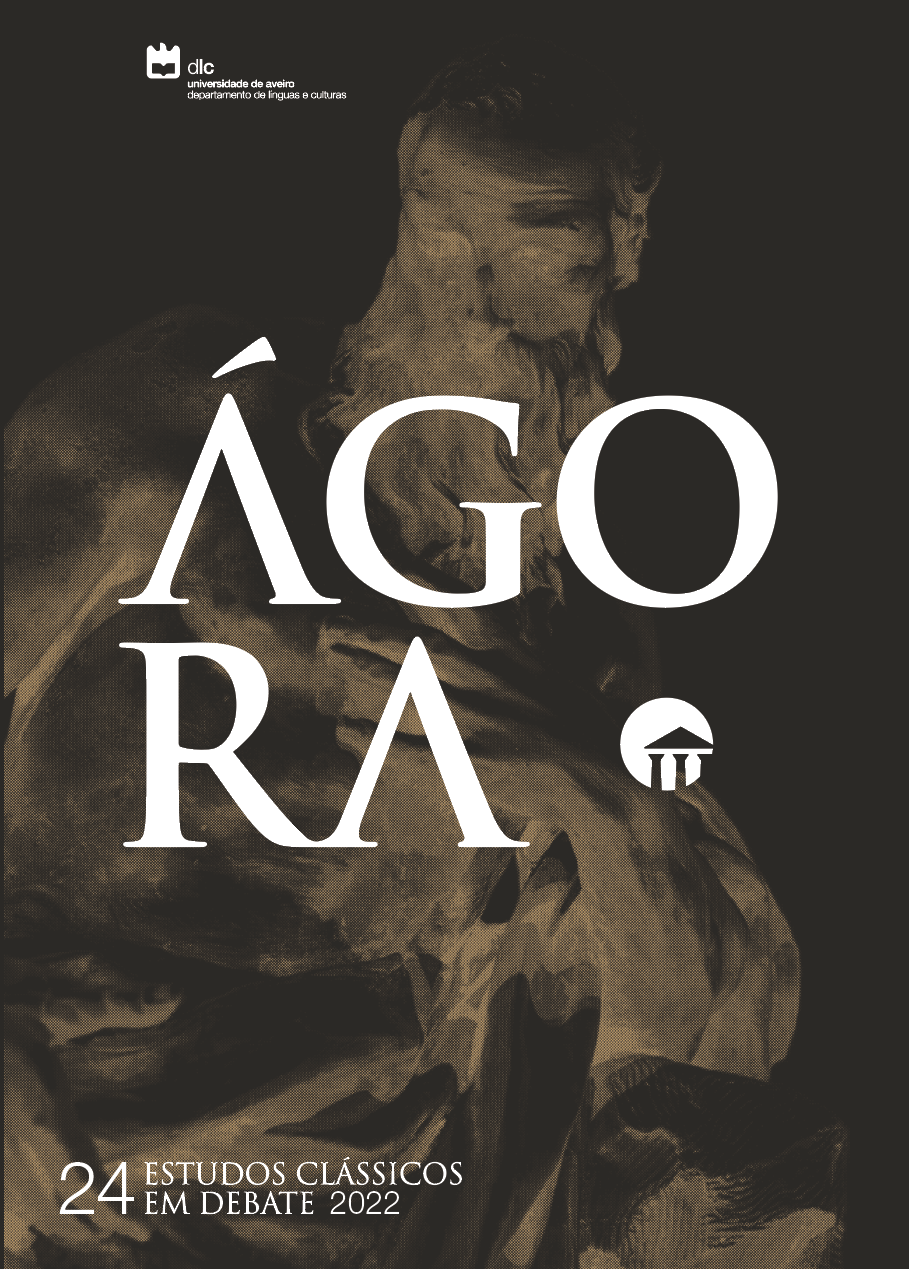Giuliano “l’antisanto”. Retorica della santità nelle Or. 4 e 5 di Gregorio di Nazianzo
Resumo
I Κατὰ Ἰουλιανοῦ di Gregorio di Nazianzo (Or. 4 e 5)" di Gregorio di Nazianzo sono una pietra miliare nella creazione dell’immagine dell’Apostata, epiteto con cui l’imperatore Giuliano (361 363) passò alla storia per aver rinnegato la fede cristiana. In questo articolo procederemo a una lettura dei due discorsi in chiave “antiagiografica”, analizzando da un punto di vista retorico e letterario le interazioni tra ψόγος e agiografia. Offriremo così alcune interpretazioni sui meccanismi della retorica della santità della tarda antichità e la sua funzione nella transizione religiosa del IV secolo.
Os Κατὰ Ἰουλιανοῦ de Gregório Nazianzeno (Or. 4 e 5) são um marco miliar na criação da imagem do Apóstata, epíteto com o qual o imperador Juliano (361-363) ficou para a história por ter negado a fé cristã. Neste artigo procederemos a uma leitura dos dois discursos em chave “anti-hagiográfica”, analisando as interações entre ψόγος e hagiografia do ponto de vista retórico e literário. Ofereceremos, assim, algumas interpretações sobre os mecanismos da retórica da santidade da antiguidade tardia e sua função na transição religiosa do século IV.
Referências
BERNARDI, J. (1983), Grégoire de Nazianze, Discours 4-5 Contre Julien. Paris, Éd. du Cerf.
BIDEZ, I. & CUMONT, F. (1923), Imp. Caesaris Flavii Claudii Iuliani Epistulae Leges Poematia Fragmenta Varia. Paris, Les Belles Lettres.
GARCÍA BLANCO, J. & JIMÉNEZ GAZAPO, P. (1982), Juliano, Contra los galileos, cartas y fragmentos, testimonios, leyes. Madrid, Gredos.
HERNÁNDEZ DE LA FUENTE, D. (2011), Vidas de Pitágoras. Girona, Atalanta.
LUGARESI, L. (1993), Gregorio di Nazianzo, Contro Giuliano l’Apostata: Oratio IV. Firenze, Nardini.
SELEM, A. (2013), Ammiano Marcellino, Le storie. Novara, De Agostini.
5.2. Fonti secondarie
AGRAIN, R. (1953), L’hagiographie : ses sources, ses méthodes, Ses histoire. Bruxelles, Société des Bollandistes.
BOWERSOCK, G. W. (1978), Julian the Apostate. Cambridge, Harvard University Press.
BRAVO CASTAÑEDA, G. (2015), “Iglesia e Imperio como sistemas de dominación: confrontaciones y compromisos”: J. FERNÁNDEZ UBIÑA, A. J. QUIROGA PUERTAS & P. UBRIC RABANEDA (eds.) (2015), La Iglesia como sistema de dominación en la Antigüedad Tardía. Granada, Universidad de Granada, 23-40.
BRAVO GARCÍA, A. (2003), “De Pselo a Pletón: la filosofía bizantina entre tradición y originalidad”: Ciencia y Cultura en la Edad Media, Actas VIII y IX, Fundación Canaria Oratova de Historia de la Ciencia (2003) 253-292.
BROWN, P. (1971), “The rise and function of the holy man in late antiquity”: The Journal of Roman Studies LXI (1971) 80-101.
BROWN, P. (1981), The cult of the saints, its rise and function in Latin Christianity. Chicago, University of Chicago Press.
CASAS OLEA, M. M. (2019), “Contenidos”: M. M. CASAS OLEA (ed.) (2019). Héroes santos: textos hagiográficos y religión popular en el cristianismo oriental, Gra-nada, Universidad de Granada, 9-33.
CELERIER, P. (2013), L’ombre de l’empereur Julien : le destin des écrits de Julien chez les auteurs païens et chrétiens du IVe au VIe siècle, Paris, Presses universitaires de Paris Nanterre.
CORKE-WEBSTER, J. & GRAY, C. (2020), “Introduction”: C. GRAY & J. CORKE-WEBSTER (eds.) (2020), The Hagiographical Experiment, Developing Discourses of Sainthood. Leiden, Brill, 1-26.
DELEHAYE, H. S. J. (1906), Les légendes hagiographiques. Bruxelles, Société des Bollandistes.
ELM, S. (2012), Sons of Hellenism, fathers of the church: Emperor Julian, Gregory of Nazianzus and the vision of Rome. Berkeley, University of California Press.
FINKELSTEIN, A. (2018), The specter of the Jews: Emperor Julian and the rhetoric of ethnicity in Syrian Antioch. Oakland, University of California Press.
FONTAINE, J. (1982), “Le culte des saints et ses implications sociologiques. Réflexions sur un récent essai de Peter Brown”: Analecta Bollandiana C (1982) 17-41.
FOWLER, A. (1982), Kinds of literature: An introduction to the theory of genres and modes. Oxford, Oxford University Press.
GREENWOOD, D. N. (2021), Julian and Christianity, Revisiting the Constantinian revolution. Ithaca/London, Cornell University Press.
IBÁÑEZ CHACÓN, A. (2019), “Mercurio de Cesarea (Capadocia)”: M. M. CASAS OLEA (ed.) (2019). Héroes santos: textos hagiográficos y religión popular en el cristianismo oriental, Granada, Universidad de Granada, 331-439.
LUGARESI, L. (1998), “Giuliano Imperatore e Gregorio di Nazianzo: contiguità culturale e contrapposizione ideologica nel confronto tra ellenismo e cristianesimo”: Rudiae: Ricerce sul Mondo Classico 10 (1998) 293-334.
MULLET, M. (1992), “The madness of genre”: Dumbarton Oaks Papers 46 (1992) 233-243.
NIGRO, G. A. (2013), “Figure imperiali negli scritti dei padri cappadoci”: Classica et Christiana 8/1 (2013) 229-269.
PERNOT, L. (1993), La rhétorique de l’éloge dans le monde gréco-romain : Tome I : Histoire et technique. Paris, Institut d’Études Augustiniennes.
SWIST, J. J. (2018), “Medicine in the thought and action of the Emperor Julian”: The International Journal of Platonic Tradition 12 (2018), 13-38.
TANASENAU-DÖBLER, I. (2017), “Neo-Platonic reading of embodied divine presence: Iamblichus and Julian”: A. K. PETERSEN & G. VAN KOOTEN (eds.) (2017), Religio-philosophical discourses in the Mediterranean world: From Plato, through Jesus, to Late Antiquity, Leiden, Brill, 338-374.
VAN NUFFELEN, P. (2020), “The Christian reception of Julian”: S. REBENICH & H.-U. WIEMER (eds.) (2020), A companion to Julian the Apostate, Leiden, Brill, 360-397.
VAN PELT, J. (2020), “The hagiographer as holy fool? Fictionality in saints’ lives”: C. GRAY & J. CORKE-WEBSTER (eds.) (2020), The Hagiographical Experiment, Developing Discourses of Sainthood. Leiden, Brill, 63-92.
VAN UYTFANGHE, M. (1993), “L’hagiographie: un «genre» chrétien ou antique tardif?”: Analecta Bollandiana: Revue Critique d’Hagiographie 111.1-2 (1993) 135-188.










